Sustainable Living
To address important and achievable goals, Corporate works with divisional management to determine and implement operating decisions to put measures in place to carry out a meaningful and purpose driven, sustainable procurement and environmental policy.
Consistently practicing annual participation in reporting to reputable organizations which allow us to consistently benchmark our business’s continued improvements and implement and act on our headquarter best practices.
At The AnsixTech, we’re committed to nurturing an ethos of environmental sustainability in everything we do. Over the years, we’ve instituted a number of green initiatives, all of which have helped us become one of the most sustainable leaders in the plastic injection molding industry.
Here at The AnsixTech, we are dedicated to participating in a global commitment to a sustainable future, with a goal of aligning ourselves with the United Nations Global Compact. We are currently a landfill free organization, and are active in monitoring and reducing our carbon footprint. We acknowledge our corporate social responsibility, and actively pursue our goals and objectives. Only by working together, can we leave a better world for tomorrow.
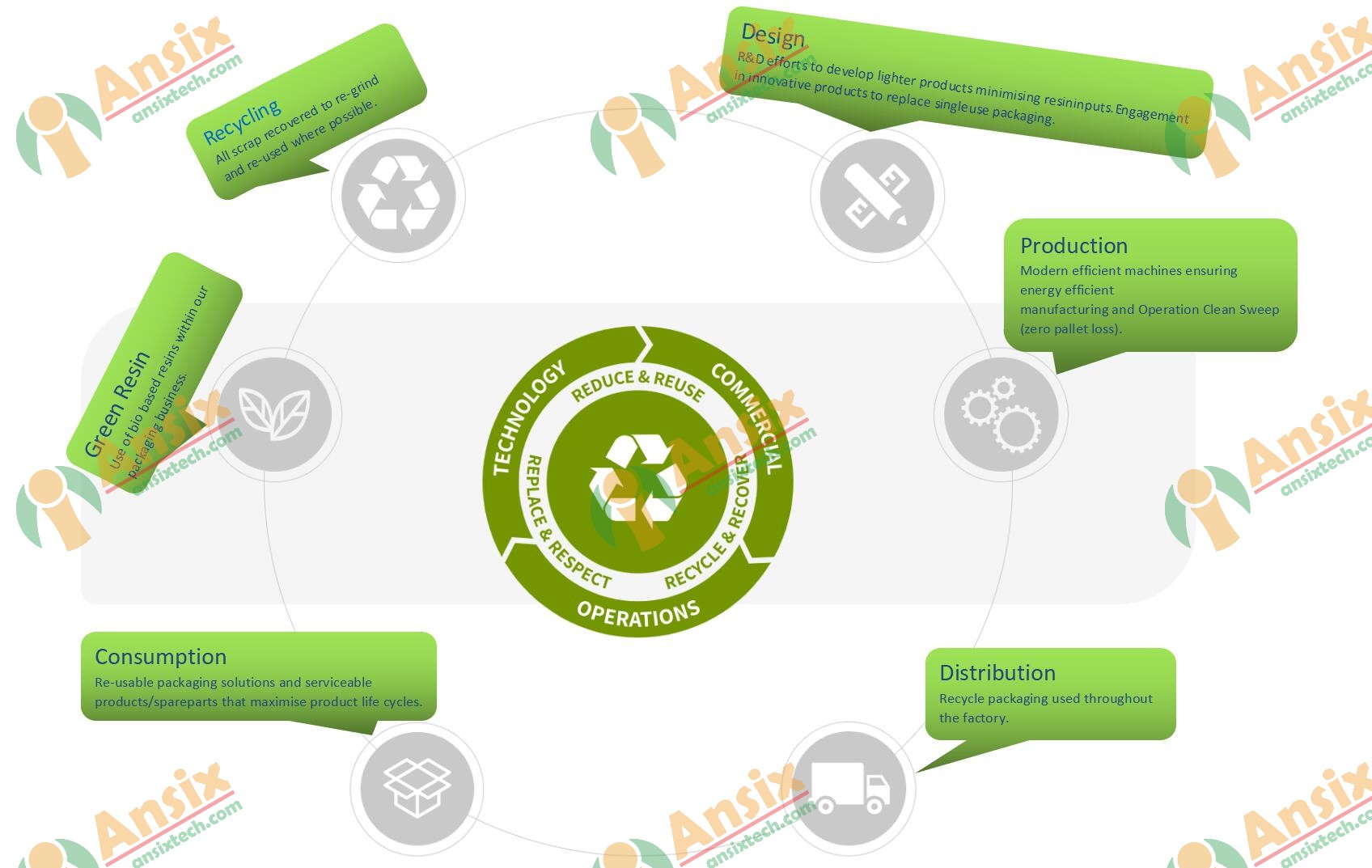
AnsixTech global drive to all-electric machines to maximize quality and productivity--Electric injection moulding machine
AnsixTech company, the global manufacturer of essential industrial components, has replaced its 185th hydraulic injection molding machine with a new electric model as part of its long-term investment program to upgrade its machine portfolio to become fully electric by the end of 2031.
The company is working with a small number of key equipment suppliers with global support networks to replace 180 machines that have been operating for 15-years or more (and currently heading towards the end of their working lives). The replacement machines are both all-electric and hybrid electric, the latter using Vireo servo drive technologies.
The machines, which are now installed at Vietnam and China, are delivering a 30% reduction of energy consumed, cycle to cycle, and an improved overall equipment effectiveness (OEE) in excess of 85%. Cycle times have reduced by an average of 15% across all two countries.
The process and productivity improvements are effectively enabling three electric machines to do the work of four hydraulic models, reducing the overall footprint. The increased capacity is complemented by the guaranteed repeatability that electric machines can deliver, ensuring even greater product quality.
Stephen Huang, AnsixTech CEO, says the substantial investment is clearly paying off: “The increased capacity and reduced energy costs are exciting for both our business and customers alike. Electric machines are more reliable and last longer than their hydraulic counterparts, and deliver significantly greater productive hours per annum. With this performance, and greater automation, we are supporting even greater efficiencies for our customers.”
Stephen says AnsixTech remains committed to its investment ambitions: “We have plans to replace further hydraulic machinery in 2024, with more than $5.5 million allocated for the roll-out of new electric machines, focusing on replacing the oldest machines first as they reach the end of their useful working lives.”
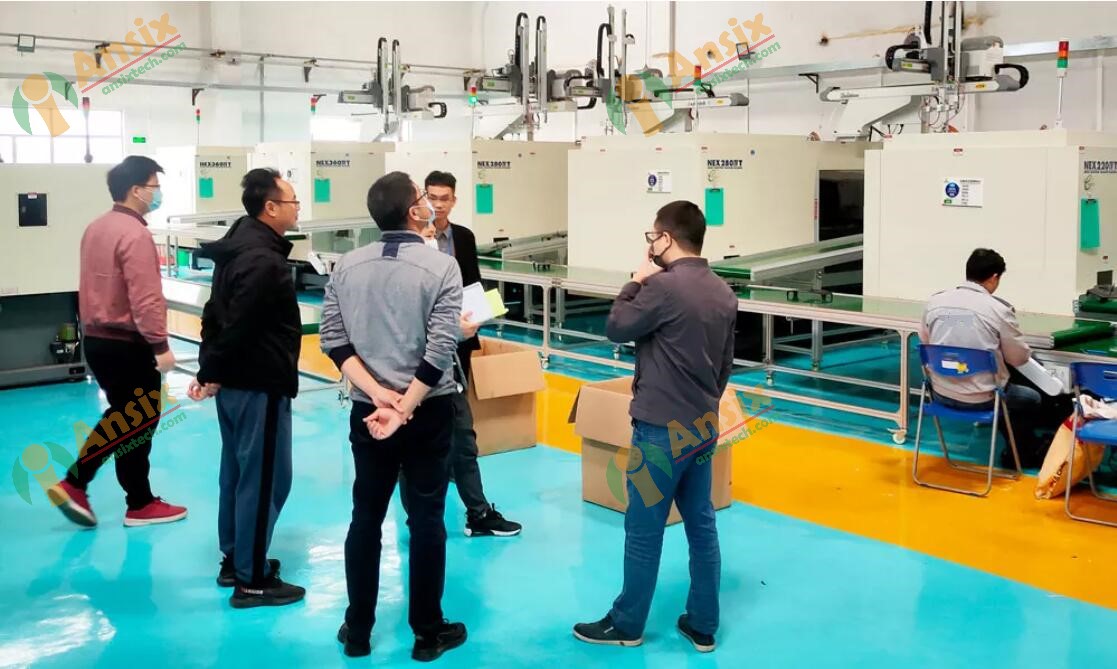
Design for Sustainability: Optimizing the injection molding process and selecting biodegradable materials
Optimizing plastic injection molding processes to align with sustainability principles is crucial in today's environmentally conscious climate. By reducing waste, energy consumption, and the environmental impact associated with plastic production, manufacturers can play a pivotal role in promoting a more sustainable future. Our guide covers:
Optimizing Plastic Injection Molding Processes for Sustainability
Environmental Benefits of Sustainable Manufacturing with Injection Molding
Economic Advantages of Sustainable Design in Injection Molding
Social and Corporate Responsibility Implications of Sustainable Manufacturing
Challenges and Solutions in Designing for Sustainability in Plastic Injection Molding
Sustainability at AnsixTech
Optimizing Plastic Injection Molding Processes for Sustainability
How can manufacturers optimize injection molding processes to have a lower carbon impact? It involves strategic decisions, process optimizations, and responsible resource management.
For more information about plastic injection molding, read our guide What is plastic injection molding and how does it work?
Now let’s take a look at the key factors to consider to make the process more sustainable.
Choosing Materials and Bio-Based Polymers
Manufacturing with recycled materials, such as recycled plastics, or choosing bio-based materials can significantly reduce the carbon footprint of injection-molded products.
For example, AnsixTech makes a number of LDPE components, including tapered caps and plugs, corner protectors, tube end plugs and tube end caps, from 98% recycled plastic. The additional 2% is made up of colorants.
AnsixTech is also investing in research and development projects, such as our Centre of Excellence at our Beijin China, focusing on more sustainable alternatives to virgin polymers. Specifically, we’re trialing materials such as bio-based polymers derived from plants and biodegradable additives blended with recycled and virgin resins. Read more in Climate change and sustainable manufacturing.
Choosing recycled or recyclable materials in injection molding can help reduce the environmental impact of manufacturing and processing materials. These materials, while occasionally more expensive upfront, can deliver energy savings or a longer product lifespan.
At AnsixTech, we place great emphasis on raw material supply chain management and delivery time accuracy and reliability. Here are some of our practices and commitments:
Supplier selection and evaluation: We establish long-term cooperative relationships with reliable suppliers and regularly evaluate their delivery on-time rate, product quality and service level. We choose suppliers who can meet our needs and have stable supply capabilities.
Forecasting and planning: We predict the quantity and time of raw materials required through market research and demand forecasting. We formulate reasonable purchasing plans and communicate with suppliers in a timely manner to ensure that the supply of raw materials can meet our production needs.
Inventory Management: We conduct precise inventory management to avoid excessively high or low inventory levels. We conduct regular inventory counts and analysis to ensure inventory accuracy and timeliness.
Supply chain collaboration: We maintain close communication and collaboration with our suppliers. We communicate demand changes and delivery times with our suppliers in a timely manner to ensure the smoothness and coordination of the supply chain.
Diversified supply chain: We have established cooperative relationships with multiple suppliers to reduce supply chain risks. If one supplier cannot meet demand, we can promptly switch to other suppliers to ensure that the supply of raw materials is not affected.
Tracking and Monitoring: We track the delivery status and progress of raw materials and promptly resolve any issues that may cause delays. We use supply chain management systems and other tools to monitor the operation of our supply chain so that potential problems can be discovered and resolved in a timely manner.
Delivery time commitment: We promise to deliver products quickly according to customer delivery time requirements. We formulate reasonable production plans and logistics arrangements based on customer needs and delivery time to ensure that products can be delivered to customers on time.
For general raw materials, we can ask suppliers to deliver raw materials to our factory within 2 hours.
Through the above supply chain management measures and delivery time commitments, we strive to ensure the timely supply of raw materials and rapid delivery of products. We continuously improve the efficiency and reliability of supply chain management to meet customer needs and expectations.

Implementing Design for Manufacturability for Efficiency and Waste Reduction
Design for Manufacturability (DFM) is a critical approach for enhancing efficiency and reducing waste in manufacturing processes. DFM focuses on designing products in a way that makes them easier and more cost-effective to produce.
This involves emphasizing simplicity in product design. Reduce the number of components and complex geometries, which can lead to increased manufacturing complexity and waste. Streamlining the design can also reduce the risk of defects.

Also important is minimizing material waste by optimizing part design and mold layout. This includes using efficient nesting techniques to reduce scrap material and designing parts with minimal excess material or trimming requirements. Carefully define tolerances for parts and components. By avoiding overly tight tolerances, you can prevent rework or scrap. Proper tolerance management ensures that parts fit together as intended without excessive adjustments.
Standardizing components and processes wherever possible reduces the need for custom parts and minimizes tooling changes, making manufacturing more efficient and cost-effective.
Balancing Cost and Sustainability Considerations in Design
By treating cost-effectiveness and sustainability as synergistic goals, manufacturers can gain a competitive edge while minimizing their carbon footprint.
Start with an early integration of sustainability. From the project's inception, prioritize sustainability as a fundamental requirement alongside cost considerations. This approach facilitates the identification of cost-effective sustainable solutions. For instance, products with lower energy consumption during use can cut operational costs and carbon emissions.
Conduct a comprehensive life cycle assessment (LCA) of your application. LCA evaluates the environmental impact from raw material extraction to manufacturing, distribution, use, and end-of-life disposal. It helps pinpoint areas for sustainability improvements that do not significantly raise costs.
Think about modularity. Design products with modular components that can be easily replaced or upgraded. This approach extends product life, lessens the environmental impact associated with disposal, and offers cost-effective maintenance.
By investing in prototyping and testing to identify potential design improvements early in the development process, this can prevent costly revisions and ensures the efficient integration of sustainability requirements.
Environmental Benefits of Sustainable Manufacturing with Injection Molding
Reduce material waste
Injection molding using renewable and recycled plastics reduces the carbon footprint and can minimize environmental impacts . This includes the use of recycled or biodegradable plastics, which help conserve resources and reduce plastic waste in landfills and oceans.
Making injection molding more sustainable aims to minimize material waste through efficient designs, optimized mold layouts, and the reduction of scrap and reject rates. This leads to cost savings and lessens the environmental impact associated with waste disposal.
Improved resource management
Sustainable manufacturing encourages efficient resource management, including reduced water usage and responsible chemical handling. These practices not only benefit the environment but also reduce operational costs.
Economic Advantages of Sustainable Design in Injection Molding
Lower operational costs
Other economic advantages involve energy-efficient manufacturing processes, machinery, and tools. This not only reduces energy consumption but also lowers operational costs, enhancing the overall economic sustainability of production.
And while sustainability initiatives may require initial investments, they often result in long-term cost savings. These savings can come from reduced energy consumption, lower material waste, decreased downtime due to maintenance, and improved efficiency.
Supply chain resilience
Injection molding in a more sustainable way can improve supply chain resilience by reducing reliance on finite or environmentally harmful resources. This can help mitigate risks – including costs – associated with resource scarcity or environmental disasters.
Social and Corporate Responsibility Implications of Sustainable Manufacturing
Improve brand image
Companies that prioritize sustainable practices in plastic injection molding can build a positive brand image and reputation. Buyers increasingly favor environmentally responsible products, which can lead to increased sales and market share.
Alignment with environmental regulations and standards <H3>
Sustainable practices also align with many environmental regulations and standards. Compliance with these regulations can mitigate the risk of fines and legal issues, further contributing to the economic sustainability of the business.
Long-term viability
Sustainable plastic injection molding supports long-term business viability by reducing dependence on finite resources and minimizing the negative consequences of environmental degradation. This ensures the business's continued operations in a changing global landscape.
Challenges and Solutions in Designing for Sustainability in Plastic Injection Molding
Designing for sustainability in plastic injection molding demands a comprehensive and collaborative approach, infusing environmental considerations into every facet of product development. By proactively tackling challenges and implementing sustainable design principles, manufacturers can diminish their environmental footprint while preserving competitiveness and responsiveness to consumer expectations.
Challenge 1: Material Selection
Choosing materials can be a complex task, as options such as bio-based polymers or recycled plastics may have limited availability, higher costs, or specific performance limitations.
Solution: Collaborate closely with material suppliers to identify sustainable alternatives and gain a comprehensive understanding of their properties and limitations. Keep a vigilant eye on the market for emerging sustainable materials.
Challenge 2: Material Compatibility
Sustainable materials, such as bioplastics or recycled plastics, may have different properties compared to traditional materials, leading to compatibility issues with existing molds and processes.
Solution: Conduct comprehensive material compatibility testing to ensure the sustainable material works seamlessly with your molds and processes. Make necessary adjustments to molds and machinery if required.
Choose molds and equipment that are compatible with the specific characteristics of the material. Implement regular maintenance and inspection routines to extend the lifespan of molds and machinery.
Challenge 3: Material Performance
Sustainable materials may have lower mechanical strength and durability compared to traditional plastics.
Solution: Optimize product designs to account for the unique properties of sustainable materials. Reinforce critical areas, or consider hybrid designs that combine sustainable materials with traditional ones to enhance strength and durability.
Challenge 4: Temperature Resistance
Some sustainable materials may have lower temperature resistance, which is counterproductive for applications that require high-temperatures.
Solution: Explore material additives or blends that can improve temperature resistance. Consider alternative sustainable materials that inherently possess better temperature resistance.
Challenge 5: Consistency and Quality
Achieving consistent quality with sustainable materials can be challenging due to variations in feedstock and material sources.
Solution: Collaborate closely with material suppliers to ensure a consistent supply of high-quality sustainable materials. Implement rigorous quality control and testing protocols to maintain product consistency.
Challenge 6: Complex Design Dilemma
Sustainable design often necessitates simplification, which may conflict with complex product requirements or desired aesthetics.
Solution: Strive for a balance between aesthetics and functionality by conducting thorough design analysis. Consider modular designs that allow for component reuse or replacement while achieving desired aesthetics.
Challenge 7: Manufacturability Hurdle
Sustainable designs might be more challenging to manufacture due to unconventional shapes or material characteristics.
Solution: Foster early collaboration between design and manufacturing teams. Utilize design for manufacturability (DFM) principles to identify and address manufacturability challenges. Prototyping and testing can play a pivotal role in refining designs.
Challenge 8: Cost Constraints
Sustainability initiatives, especially in the initial stages, can inflate production costs, potentially misaligning with budget constraints.
Solution: Adopt a long-term perspective by factoring in cost savings achievable through sustainable practices over time. Explore government incentives, cost-sharing partnerships, and life-cycle cost analysis to justify initial investments.
Sustainability at AnsixTech
At AnsixTech we are aiming to be the world’s leading, responsible, hassle free supplier of essential industrial components. We are committed to supporting our customers to achieve their sustainability goals and objectives, by developing sustainable industrial component solutions for them.
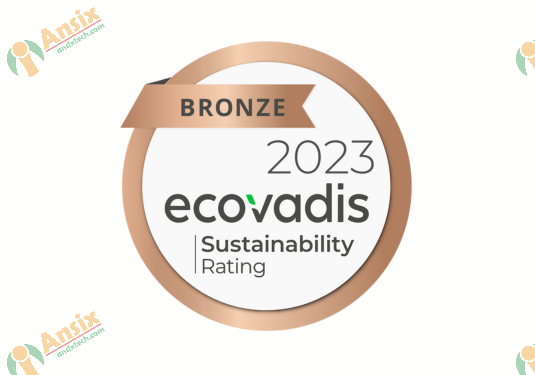
Sustainable Plastic Injection Molded Materials
We believe that plastics are an incredible material that has caused humans to live better, healthier and longer because of plastics.
We recognize that, when improperly managed, plastics can be harmful to the ecosystem. We believe the long-term solution for the full benefit of humanity and the planet is to fully engage a circular economy. We are committed to work with our clients to support the design and planning for the complete life cycle of every product to be manufactured, used for it’s intended purpose, collected and fully reprocessed/“reincarnated” into a new product or designed to be responsibly disposed of in a way that that the product can return to basic elements.
We are a processor of synthetic and natural polymers. Our machines process materials manufactured by a variety of industry partners into consumer, agricultural, construction, medical, and industrial parts.
The materials are specified by our engineers to match the requirements of the product application. Typically, these requirements include mechanical attributes such as tensile strength, ductility, impact resistance and heat or cold temperature performance or chemical attributes such as resistance to fading from U.V. light exposure or performance when exposed to solvents or acids.
What are sustainable plastics?
By definition, sustainable plastics are managed within a sustainable materials management system (a Circular Economy) to avoid the creation of waste, toxics and pollution.
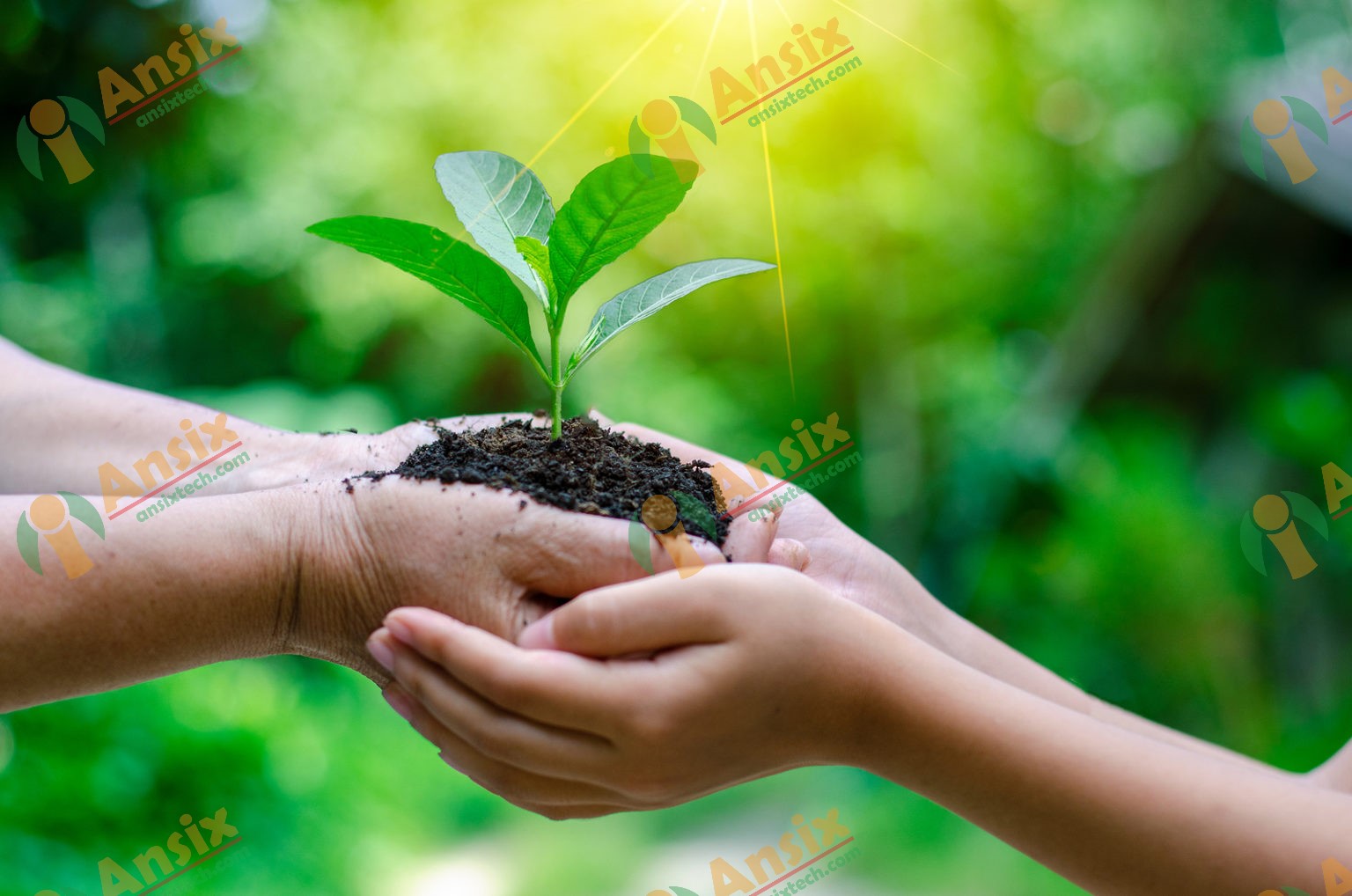
What is a circular economy?
A circular economy is an alternative to a traditional linear economy (make, use, dispose) in which we keep resources in use for as long as possible, extract the maximum value from them while in use, then recover and regenerate products and materials at the end of each service life.sustainable injection molding.
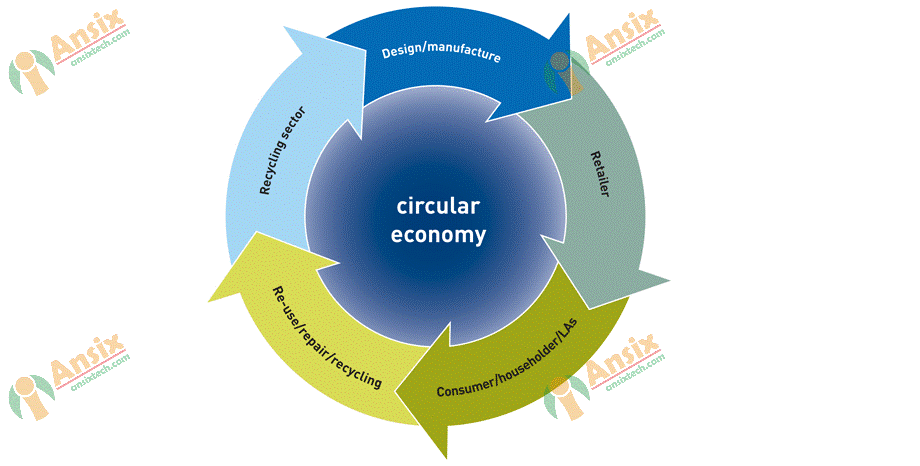
Sustainable material classifications
Bio Polymers/ Bioplastics - Bioplastics are plastics derived from renewable biomass sources, such as vegetable fats and oils, corn starch, pea starch or macrobiotic.
Bioplastic can be made from agricultural byproducts and also from used plastic bottles and other containers using microorganisms. Bioplastics can be composed of starches, cellulose, biopolymers, and a variety of other materials.
Compostable Plastic - A plastic which is “capable of undergoing biological decomposition in a compost site.
“As part of an available program, the plastic breaks down to carbon dioxide, water, inorganic compounds, and biomass at a rate consistent with known compostable materials and leaves no toxic residue” (ASTM) Compostable is different than biodegradable by the fact that it must be contained in specific sites and specific environmental conditions.
Biodegradable - Biodegradable plastic is plastic that’s designed to break up when exposed to the presence of microorganisms.
It is usually made from natural byproducts, and follows rigorously controlled conditions of temperature and humidity in industrial environments. Most biodegradable and compostable plastics are called bioplastic and they are generally made from plants (such as bamboo or sugarcane) rather than fossil fuels.
Recyclable Plastic
Recyclable Plastic - A plastic that can be reclaimed, reprocessed and returned back into the production stream of useful products.
Plastics have been segregated into 7 categories identified with the recycle symbol and a number designating the type of plastic.

Packaging Conservation
Our Commitment To Sustainability
We buy our largest volume resins in bulk and store them in silos, with nearly 10,000,000 lbs of resin annually. We recycle more than 20% of all cardboard boxes coming into AnsixTech facilities, and this percentage continues to grow every year.
We also conserve cardboard on the way out, making use of servo robots to stack completed goods for shipping. Not only does this reduce packing time, but it also reduces wasted space. Today, cartons shipped from AnsixTech are between 300% and 400% more full than they were in the past, significantly reducing overall cardboard use. We’re proud to offer all of our customers a returnable and reusable packaging program as well.
Energy Conservation
We joined China’s 2035 plan for energy conservation, emission reduction and carbon neutrality. program to improve our energy-use practices, implementing various common-sense energy savings initiatives, such as simple motion-sensor-activated lighting setups to save electricity. We’ve also established more complex demand-response operations; for instance, we reduce our energy use during peak periods of demand (usually during the extremely hot summer months) to help maintain electricity availability for the surrounding community and minimize the risk of blackouts.
Nontoxic Materials
All colorants, resins, lubricants, and cleaners — every chemical used during production in AnsixTech facilities — are guaranteed to be nontoxic and nonhazardous. Additionally, the medical grade resins we use are FDA approved, and all of the resins we use for our large-volume molding processes are RoHS, REACH, and NSF compliant.
These nontoxic chemicals and resins are not only better for the environment, but they’re also better for our staff, our customers, and our end consumers.
Environmental stewardship
All AnsixTech employees support the single-stream recycling program within the facility. and family members can recycle household items including used lights, electronics, computer equipment, batteries.
At The AnsixTech, we take corporate responsibility seriously and are committed to environmental stewardship.
AnsixTech believes it has an important duty to ensure good environmental performance in all its business operations and to provide the necessary organization, commitment, and training to fulfill this obligation. The senior management firmly believes in, and is committed to monitoring and improving environmental performance, pollution prevention and environmental protection. If we can help you with your project please call us at 400 109 0029 or contact us here.

Packaging Conservation
Our Commitment To Sustainability
We buy our largest volume resins in bulk and store them in silos, with nearly 10,000,000 lbs of resin annually. We recycle more than 20% of all cardboard boxes coming into AnsixTech facilities, and this percentage continues to grow every year.
We also conserve cardboard on the way out, making use of servo robots to stack completed goods for shipping. Not only does this reduce packing time, but it also reduces wasted space. Today, cartons shipped from AnsixTech are between 300% and 400% more full than they were in the past, significantly reducing overall cardboard use. We’re proud to offer all of our customers a returnable and reusable packaging program as well.
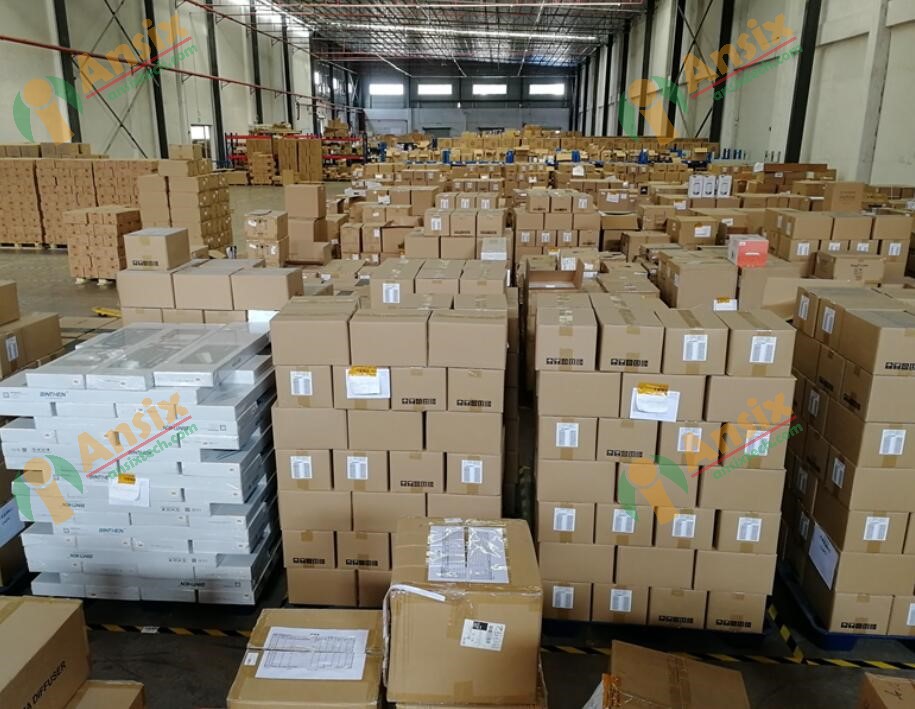
Environmental Management System (ISO14001)
Well-defined principles and clear objectives
During our daily operations from design to production, we take up social responsibilities with a view to minimising the impact on the environment. We makes continuous improvements in the prevention of pollution, energy saving, wastage control and recycling.
We fully understand the importance of environmental management. We educate our employees about the importance of environmental protection and environmental friendly production. We take up social responsibilities, and cooperate with outside organisations to contribute our best to the protection of the environment of EVA and the Earth.
Well-developed system and effective implementation
Our environmental management system is well developed and operates in accordance with international standards. We were accredited with ISO14001: 1996 certification by the BSI group in 2003, which was upgraded to ISO14001: 2004 certification in 2007. As the international standards for environmental protection is continuously being upgraded, our environment management system also improves accordingly. Since the establishment of EVA, we have strictly complied with the relevant laws and standards. Therefore, no incident causing environmental damages has ever occurred.
Social responsibilities for environmental protection
"Preventing pollution, treasuring the resources, loving the Earth and beautifying the environment" are our values, obligations and missions!
Environmental and hazardous substances management (WEEE and RoHS)
Well-developed systems and clear objectives
We developed our own environmental management system using the requirements of ISO9001: 2000, ISO14001: 2004, WEEE and RoHS as the foundation. We implement stringent controls on all manufacturing procedures covering the purchases of raw materials, production and deliveries. If necessary, we will take our products to the relevant authorities for environment protection testing. At present, all suppliers and production partners have entered into RoHS agreements with us and submit their product testing reports to us regularly. At the same time, we have also entered into agreements with our customers for not using toxic and hazardous substances in our production processes with a view to achieving our environmental management objectives. Our objectives for environmental protection are as follows:
Not to purchase products containing toxic and hazardous substances!
Not to manufacture products containing toxic and hazardous substances!
Not to sell products containing toxic and hazardous substances!
Accolades from customers
With a view to complying international standards, we have been continuously improving our management systems together with our customers. We upgrade our management systems continuously and therefore we received various accreditations from customers. We were awarded with the "Certificate of Green Activity" from Canon in 2004 and the certificate for chemical substances management (CMS) standard from Ricoh in 2005.

OUR CUSTOMERS
This pillar focuses on supporting our customers to achieve their sustainability goals. As the only global manufacturer and distributor of our kind, we are in a leading position to assist customers by providing products and services that have been developed to provide a hassle free sustainable choice.
Our focus and targets
Increasing the number of products introduced with sustainability credentials
Our progress
22 trials completed for new products using recycled materials in 2023
Our purpose is to help customers build a sustainable future and therefore working with them on their approach to sustainability is a key area of activity. We are committed to continuing to invest in developing new products with improved sustainability performance and lower lifecycle emissions, and providing our customers with expert advice on the most sustainable choice for their needs.
In 2023 several trials were conducted with the view to increase our recycled content from 50% to 100% across our standard ranges of LDPE parts. These trials were largely successful and we now run most standard LDPE parts at 98%-100% recycled content. We also conducted trials on our nylon products using recycled material and in 2024 will progress these trials.
We are currently in discussions to support circular economy models with targeted customers, and increasing our commercial focus on ESG supportive categories such as renewable energy and electrification, to support customers’ net zero transition.Empowering our customers to achieve more with less — less material, waste, energy, emissions, and water — is integral to all we do. For over 25 years, Chem-Trend has been solving for sustainability by heavily investing in research and innovation. As we develop next-generation technologies to enable more efficient manufacturing processes, we also work to revolutionize the efficiency of our own facilities across the globe.
